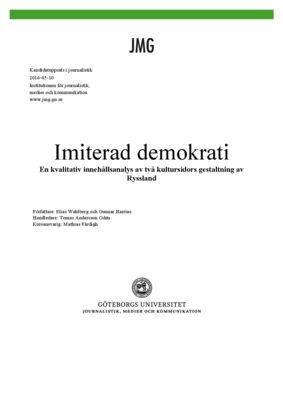Imiterad demokrati
En kvalitativ innehållsanalys av två kultursidors gestaltning av Ryssland
In January of 2017 Martin Kragh and Sebastian Åsberg published a research article titled “Russia’s strategy for influence through public diplomacy and active measures: the Swedish case”. One of the main theses of the research article was that the cultural pages of Swedish tabloid Aftonbladet repeatedly uses narratives from Russian government operated news agency Sputnik, often accused of being a Russian propaganda outlet. Aftonbladet Kultur resented the accusation and a Swedish researcher pointed out methodological flaws in the article, flaws
Martin Kragh later warded off.
One of the dominant themes Kragh and Åsberg found in the articles in Sputnik was that of a “positive image of Russia”. We argue that if Aftonbladet Kultur were to use narratives from Sputnik and thereby spread Russian propaganda, one would be able to detect a positive image of Russia in their reporting. The purpose of this study is to determine whether Martin Kragh and Sebastian Åsbergs accusations against Aftonbladet Kultur are legitimate.
In this bachelor thesis we examine whether Aftonbladet Kultur are spreading a positive image of Russia. The method used is qualitative comparative text analysis and the theories taken into consideration are framing theory, attribution theory and Karen Phalet and Edwin Poppe´s theory of evaluation of national stereotypes through competence and morality. By looking at the
overall image of Russia presented in Aftonbladet Kultur and also comparing it to the cultural pages of the other major Swedish tabloid, Expressen, we seek to determine whether the image presented in Aftonbladet Kultur is unreasonably positive.
The main findings in this study are that the image of Russia presented in the cultural pages of both tabloids is negative. There are small differences between the two cultural pages, one of them being the way they explain negative Russian actions. Aftonbladet Kultur are more likely to explain negative behaviour with external factors like outside pressure, while Expressen Kultur explain nearly every negative action with internal factors like the temper or underlying motives of the Russians. Also Aftonbladet Kultur are less likely to paint the picture of Russia as a threat than Expressen Kultur are. In both cultural pages Russia’s morality is described as low whereas their competence in Expressen Kultur most often is described as high and in Aftonbladet Kultur described as somewhat lower. With the differences being small we find that Aftonbladet Kultur are not spreading a positive image of Russia in the articles studied.
Keywords: Russia, Putin, Framing, Attribution, Aftonbladet Kultur, Expressen Kultur

